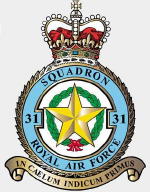Corgi AA33611 RAF Panavia GR. Mk. 4 Tornado Fighter-Bomber - ZA447/DE, No.31 Squadron, RAF Marham, England, 2006 [Low-Vis Scheme] (1:72 Scale)
"Obsolete weapons do not deter."
- British Prime Minister Margaret Thatcher
 During the late 1960's a number of European countries examined ways to replace their existing fleet of combat aircraft using next-generation design techniques. Several countries looked at variable geometry wing configurations as a means of making a plane perform well throughout a wider flight envelope. Variable geometry allows the pilot and/or fly by wire system to adapt the aircraft's wing shape to the optimal settings dependant on its height, speed, and load. The Tornado takes this one step further and incorporates swiveling weapons pylons that always ensure the stores are parallel to the airframe, thus minimizing drag and improving airflow across the entire surface of the aircraft especially at low altitudes.
During the late 1960's a number of European countries examined ways to replace their existing fleet of combat aircraft using next-generation design techniques. Several countries looked at variable geometry wing configurations as a means of making a plane perform well throughout a wider flight envelope. Variable geometry allows the pilot and/or fly by wire system to adapt the aircraft's wing shape to the optimal settings dependant on its height, speed, and load. The Tornado takes this one step further and incorporates swiveling weapons pylons that always ensure the stores are parallel to the airframe, thus minimizing drag and improving airflow across the entire surface of the aircraft especially at low altitudes.
Britain and France joined forces on a variable geometry aircraft project, called the Anglo French Variable Geometry (AFVG) project. France was already in the process of developing a variable geometry airframe of its own. In 1968, Germany, Holland, Belgium, Italy, and Canada formed a working group to look at replacements for the aging F-104. The outcome was initially called the Multi-Role Aircraft (MRA) project, which was later changed to the Multi-Role Combat Aircraft (MCRA). Britain later joined this group on the strength of its variable geometry design.
Pictured here is a 1:72 scale replica of a RAF Panavia GR. Mk. 4 Tornado fighter-bomber that was attached to 31 Squadron, then deployed to RAF Marham, England, during 2006.
Sold Out!
Dimensions:
Length: 11-1/4-inches
Wingspan: 11-inches
Release Date: February 2010
 Historical Account: "Goldstars" - No. 31 Squadron of the Royal Air Force, known as the 'Goldstars', currently operates the Tornado GR4 from RAF Marham, Norfolk.
Historical Account: "Goldstars" - No. 31 Squadron of the Royal Air Force, known as the 'Goldstars', currently operates the Tornado GR4 from RAF Marham, Norfolk.
In 1991, No 31 Sqn was the lead Squadron of the Dhahran Tornado GR1/GR1A detachment during Op Granby (Gulf War 1). Under the overall command of Wing Commander Jeremy (Jerry) Witts, the composite squadron was principally comprised from 31 Squadron with elements of Nos IX, 14 and 17 Squadrons together with a reconnaissance flight formed from elements of Nos II (AC) and 13 Squadrons. Aircrew from Nos 12 and 617 Squadrons were also attached. Wing Commander Witts was subsequently awarded the Distinguished Service Order (DSO) for his actions.
In 2003, within Operation Telic, during the Iraq War, No. 31 Squadron was the lead Squadron that formed the Ali Al Salem Combat Air Wing in Kuwait. An amalgamated Composite squadron of 31, 9, 617 and II Squadron crews under the overall command of Wing Commander Paddy Teakle (OC 31 Squadron at the time). His actions, in command of the Squadron, earned him the DSO.





 Corgi Tornado
Corgi Tornado 


